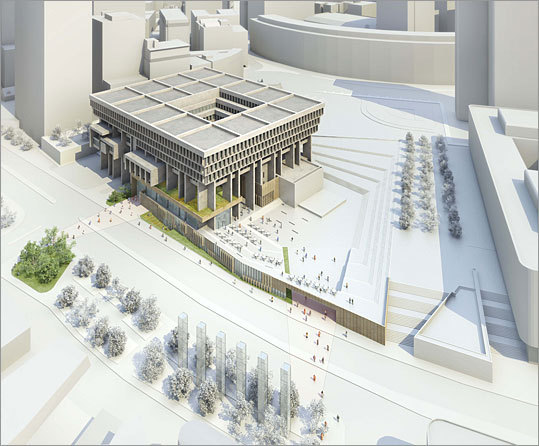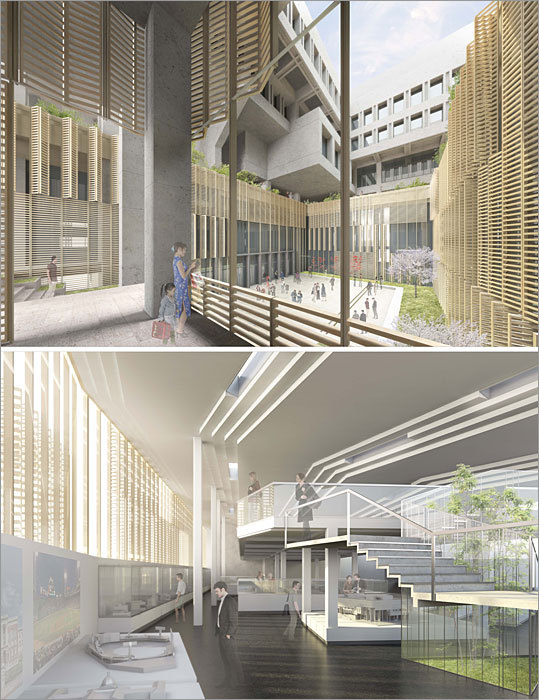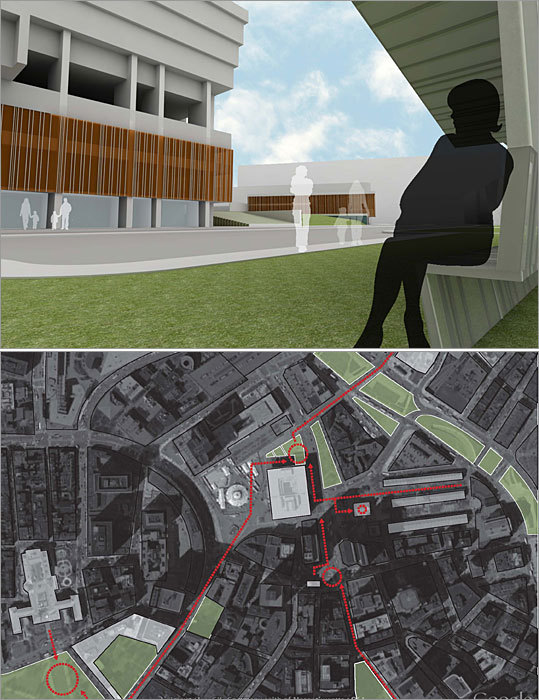Young architects offer visions for turning plaza into something a bit more welcoming
Imagine the brutish Boston City Hall with its three-story brick base replaced by glass walls, the lower levels seemingly part of one long open space stretching to Faneuil Hall. Or perhaps it could be paired with a new wing of glass-enclosed shops, or even a new building altogether, adding space and a rooftop garden to brighten its gray facade.
Re-imagining City HallThose were the visions created by finalists in the Boston Society of Architect’s annual Rotch design competition, a sort of “American Idol’’ for young architects. The challenge for the six contestants happened to be a subject very much on the minds of Boston officials: Transforming City Hall and the desert of brick around it, while adding a particular component — a museum focused on Massachusetts history — to its lower floors.
Though ultimately a hypothetical exercise, the Rotch contest showed the potential for remaking the much-reviled City Hall and its sprawling empty plaza at a time when its fate is in limbo. Mayor Thomas M. Menino has suspended his plan to build a new city hall on the South Boston waterfront, and in the interim, architects, urban planners, and civic activists have hotly debated what to do with a building that seems to have few friends.
Indeed, the young architects’ proposals were well-received within City Hall itself. Boston’s chief planner, Kairos Shen, who also served as a judge in the competition, said some of the changes could — for fairly short money — make the building much more inviting.
“Unlike previous efforts to remake City Hall and the plaza,’’ Shen said, “these kinds of interventions seem more doable. Some simple changes like this could be achievable in the near term.’’
The Rotch contest winner was Christopher Shusta, who sought to soften the building’s imposing presence while also adding attractions to bring more visitors to the site. He would build the museum in a horizontal stretch along Congress Street, adding above it an outdoor terrace that faces the area of the plaza where concerts and other public events are currently held.
Then Shusta would extend City Hall’s interior courtyard, a dark, disused space, out through the side of the building, connecting to the terraced area. The interior glass walls would look onto a newly brightened courtyard, which would be draped with geometrically shaped wooden shutters in natural finish.
“The thought is to bring some human scale to the building that people see as missing now,’’ said Shusta, a graduate of the Harvard Graduate School of Design who lives in Princeton, N.J. He received a $37,000 scholarship to travel the world studying architecture for a minimum of eight months.
Despite the building’s widespread unpopularity, City Hall officials have resisted calls for its renovation — or demolition — for years. The building, designed in the Brutalist style by the firm Kallman, McKinnell and Knowles, was built between 1961 and 1968. Its powerful concrete columns were meant to symbolize the organization of city government, with large open spaces for the public to gather.
In the 1990s, a group called the Trust for City Hall Plaza, led by developer Norman B. Leventhal, proposed building a hotel on the plaza to generate money for renovations. That effort failed, as did other initiatives to add a pavilion and other structures along Cambridge Street to infuse life into the plaza.
Now, a new source of activity has emerged at its opposite side, with the Rose Fitzgerald Kennedy Greenway opening up the landscape around that part of Boston, making City Hall more easily seen from locations near the North End and Boston Harbor. That can be either a good or a bad thing, as City Hall has both critics who say it is an ugly mistake from a misguided era in architecture and defenders who want it preserved as a monument to the period of urban renewal that reshaped downtown Boston.
The tension between those viewpoints prompted architect Tim Love, principal of Utile Inc., to suggest that the Boston Society of Architects make it the focal point of this year’s Rotch competition. Love said he wanted the young architects — and city officials — to consider a compromise between the two extreme views that would transform City Hall’s facade and add a history museum to attract visitors.
“There is a more nuanced middle ground that should be explored for many of these midcentury buildings,’’ said Love, who also served as a judge. “I also wanted to raise the question of whether the museum would help energize this part of downtown.’’
A civic organization has been trying, unsuccessfully so far, to win the right to build a Massachusetts history museum on a sliver of land near the Greenway.
Frank Keefe, president of the Boston Museum group, plans to review the Rotch contestants’ designs, but said the Greenway remains a more desirable location. “Our economic advisers tell us it’s the best museum location in the world,’’ he said.
The Rotch contestants focused heavily on drawing pedestrians, especially from the Greenway, largely by opening up City Hall’s Congress Street facade with galleries, shops, or parks. As for the museum, the young architects had provocative ways to use it to break up City Hall’s hard exterior and its barren plaza.
Andrew Steingiser of Malden proposed putting historical exhibits or other information in a series of pavilions along Congress Street. His design called for the removal of the large brick barrier around the base of City Hall, replacing it with a sweeping glass facade that would make the building more accessible.
Meanwhile, this year’s Rotch runner-up, Eric Weyant of Concord, would build a low-rise building next to City Hall for the museum galleries. The building would serve as a new entry point to the area for visitors and have large windows offering sweeping views, while adding a cafe and bookstore across from Faneuil Hall and Quincy Market.
Another design by Cynthia Dorta-Quinones of Allston has small parks in the current amphitheatre space and an outdoor cafe and new transit stop that would be aligned with Hanover Street where it crosses over from the North End.
“The scheme hopes to leave the user with a sense of openness and easy fluidity,’’ she wrote in her submission. “Its lightness and translucency are meant to contrast with the heavy structure of City Hall.’’
By Casey Ross for Boston Globe April 4, 2010



No comments:
Post a Comment